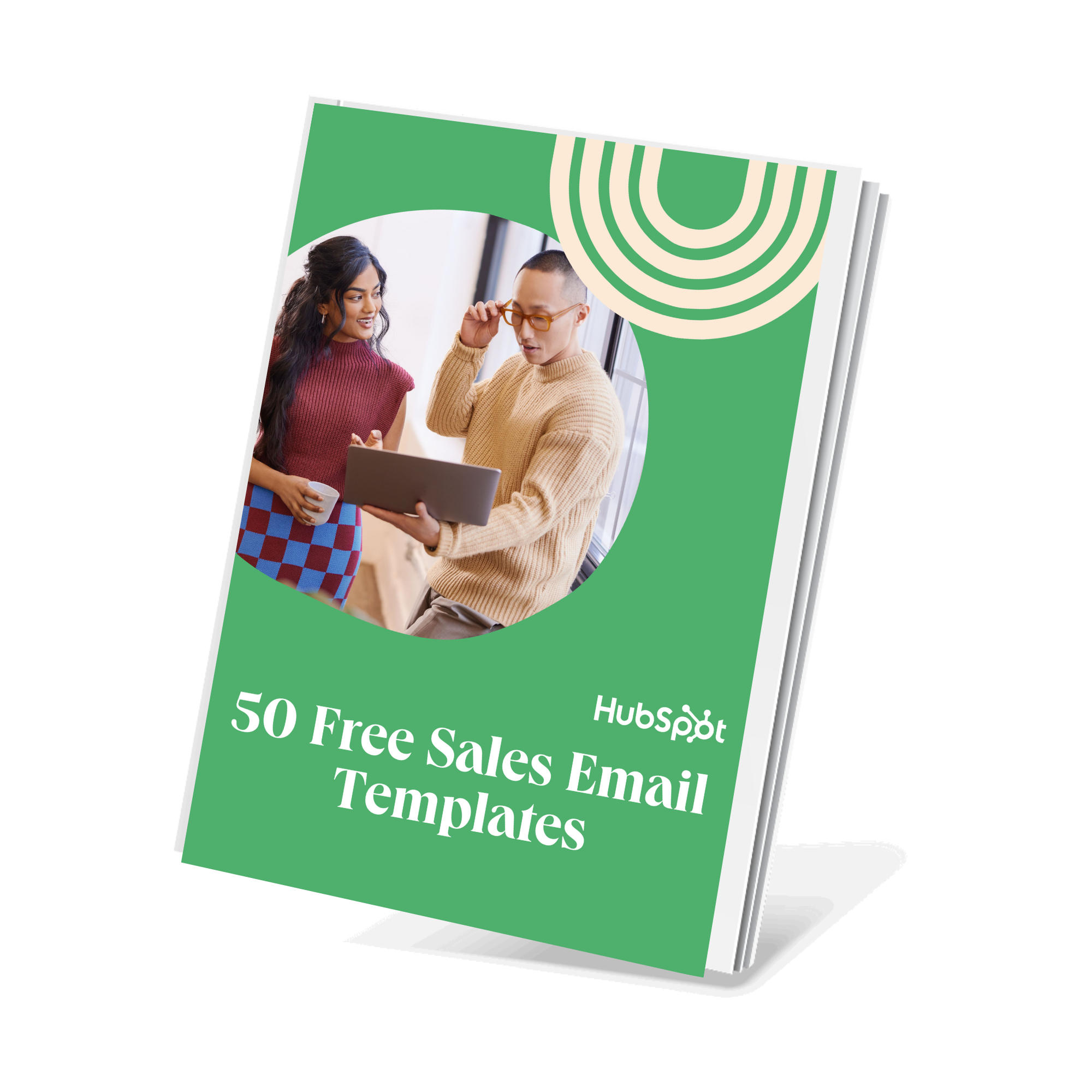Table of Contents
- Sales Prospecting Tips for Modern Selling
- Sales Prospecting Email Templates
- How to Write a Sales Prospecting Email That Gets a Response
Sales Prospecting Tips for Modern Selling
1. Start social, stay natural.
LinkedIn is where business conversations belong. You’re meeting people in their natural habitat where they expect professional connections, not cold pitches.
I like to think of it like striking up a conversation at a networking event, not cornering someone in an elevator.
Plus, let’s be real: Email screams “sales pitch” before they even open it. Instead, I recommend thoughtful comments to keep you visible to your target audience.
2. Master meaningful engagement.
Stop the “Great post!” comments — they’re just noise. If you’re going to show up, add something that makes them think. Build on their point, push the conversation forward, and make them the star.
Here’s how I find it best to do: Agree briefly → Add insight → Ask a question.
For example:
Instead of “Great post!” try: “I loved your point about buyer hesitation. Have you found that early-stage case studies help address that?”
It’s about showing you care enough to engage, not just spray and pray.
3. Respect the relationship timeline.
There’s an order to this: Comments → DMs → Email. Jumping straight from “nice post” to “Can I have a call?” is creepy. Build the relationship before you switch lanes.
Here’s how I make the jump:
When I DM, I reference our public conversation:
“Hey [Name], I enjoyed our chat on your post about outbound tactics. Thought I’d connect here!”
Why take your time? Because people warm up to contributors, not pitchers. Commenting is low-pressure, with no commitment, so they get to know you without their guard up.
Let them recognize your name before you ever hit “send” on that DM.
4. Focus on quality over scale.
Forget about chasing numbers. You can’t automate authenticity — and that’s your edge. Focus on real conversations, even if it’s just a few. The right connection beats 100 cold contacts every time.
I ask myself: What do they care about? Then, I reference it directly:
“I saw your post on outbound tactics — your point on timing was spot-on. Curious how you handle follow-ups with no response?”
No templates. No fluff. Just real conversations. And here’s why it works: Genuine conversations build rapport faster — and warm leads convert more often than cold contacts.
5. Warm up cold outreach.
Here’s the play: Use social to get familiar, then carry that warmth into email. The email shouldn’t feel like an intro — it should feel like a continuation.
Here’s how I structure my outreach:
- Reference their content.
- Relate it to my experience.
- Invite conversation without pitching.
Like this:
“Hey [Name], I really enjoyed your post on follow-up timing. It made me rethink my approach. Thought I’d reach out and connect directly.”
See what happened there? Just picking up the conversation where you left off.
Sales Prospecting Email Templates
Whether you’re an SDR making first contact or an AE nurturing key accounts, you’ll find battle-tested prospecting emails for every scenario, from cold outreach to re-engagement.
Cold Outreach Templates
Cold outreach isn’t about selling on the first touch. It’s about starting a conversation that earns you the right to sell later.
You’re reaching out to people who don’t know you and don’t trust you. Honestly? They probably don’t care much about you.
That’s why the best cold outreach emails don’t pitch. They spark curiosity, offer value, or find common ground. Your goal isn’t to close a deal. It’s to get a reply.
Below are cold outreach templates that help you do just that. Use them when reaching out to prospects who are cold but qualified. The people who fit your ICP but have no idea who you are (yet).
1. Congratulate them.
There’s more information available about prospects today than at any other time in the history of selling. That means there are plenty of prospect success stories out there for you to find.
Visit your prospect’s website for funding updates, search Google for company news, and view LinkedIn to learn about the prospect’s professional dossier. Then, append all this information to your contact records.
Once you’ve found the perfect opportunity to congratulate the prospect, don’t try to pitch them. Simply share a genuine compliment.
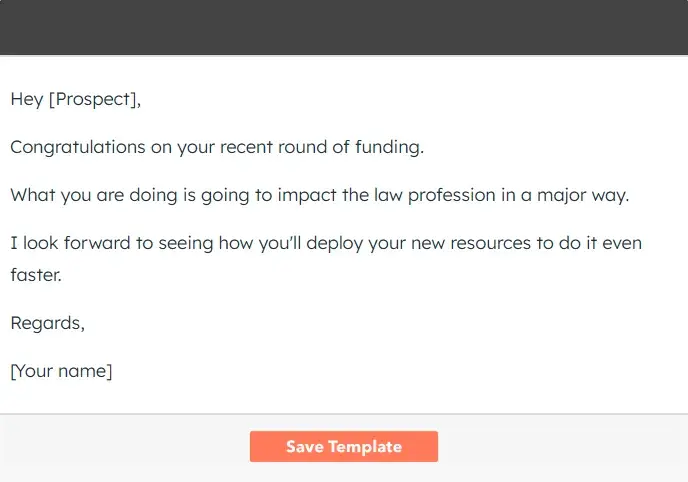
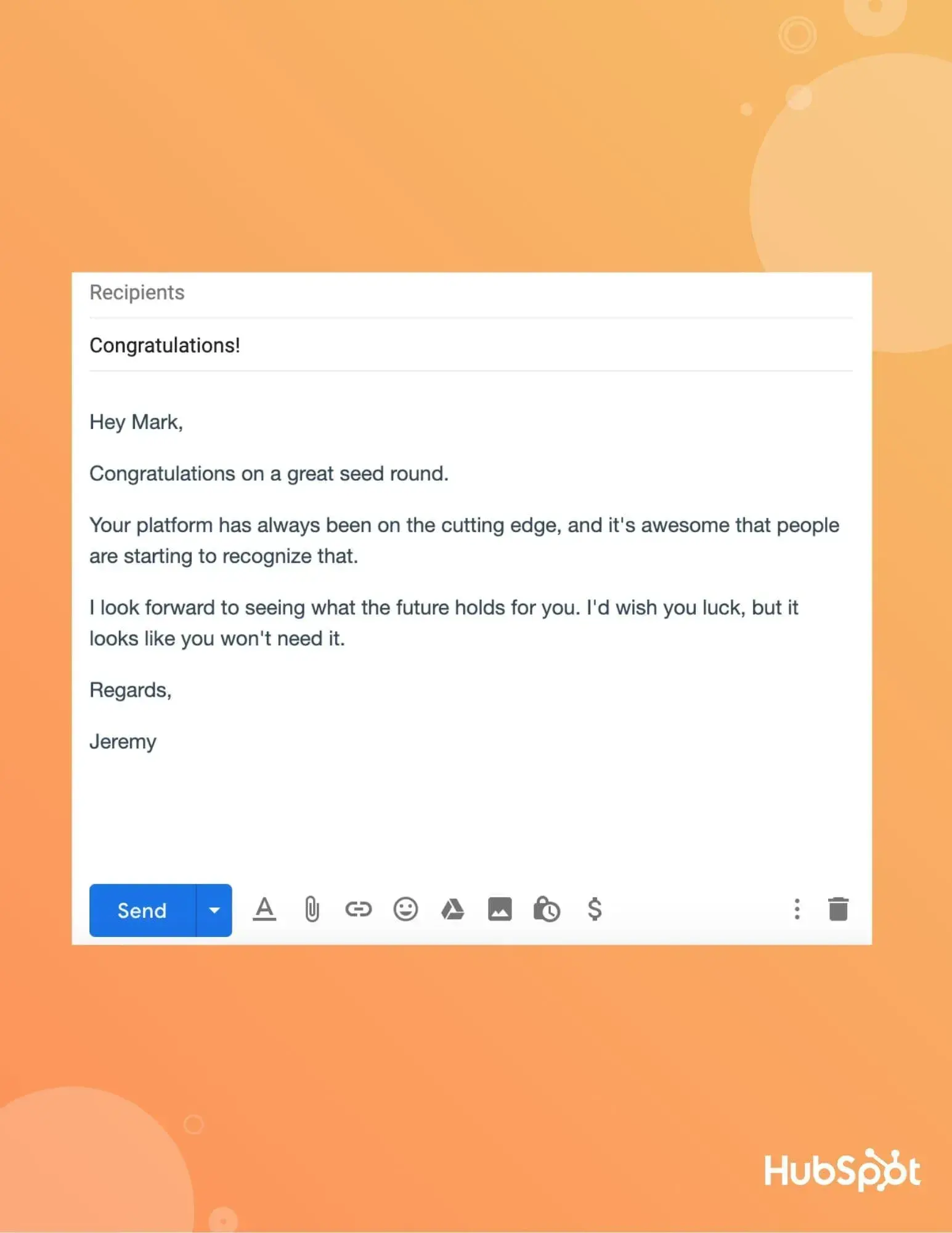
Why this email works: This approach is creative and personal. Flattery is always welcome, and it’s possible you’ll get a “Thank you, but who are you?” in response.
2. Boost their mission.
Try this approach with executive leaders. Executives and business owners are usually the creators of their vision and are most involved with communicating it. Publicity is the name of the game, especially in startups and small businesses.
Hey [Prospect],
Congratulations on your new role as VP of Marketing. Based on your LinkedIn profile, you’ve done an amazing job developing your career at [company].
If there are ways I can help you get your message out to my network of [title of people they’re trying to reach], please let me know. I’m a fan, and I want to help.
Do you have a PR or content person on your team?
Regards,
[Your name]

Why this email works: This email is genuine and applicable to just about any company.
It’s hard for the recipient of this email to turn down an opportunity for free publicity, so you’ll likely be able to get your foot in the door by offering your platform to promote their mission.
3. Provide immediate value.
Find a way to provide some value upfront, even if it’s your own expertise. Just be careful not to be critical in your first email. Starting with a compliment can soften the critique.
Hey [Prospect],
Your website’s design is absolutely brilliant. The visuals really enhance your message, and the content compels action. I’ve forwarded it to a few of my contacts who could benefit from your services.
When I looked at your site, though, I noticed a mistake in search engine optimization. It’s a relatively simple fix. Would you like me to write up the fix and share it with your web team? If this is a priority, I can also schedule a call.
Regards,
[Your name]

Why this email works: Software companies have mastered providing immediate value for free through freemium business models, creating some of the fastest-growing businesses ever.
Free feature-limited or usage-limited software offers value before any money changes hands.
If you’re a service provider, partner with a software company that has a freemium model. For example, if you’re an accountant, partner with Expensify to introduce free expense report tools.
If you sell sales training services, recommend a product like HubSpot’s free email tracking tool. As long as you are the person introducing free value, prospects will appreciate it.
4. Offer help.
Remember, your goal in the initial email is to simply get a response. With this in mind, an immediate fix the prospect needs might not be related to the products or services your business offers.
That doesn’t mean you can’t still offer help. Here’s how to do it:
Hey [Prospect],
Welcome to town. My family and I enjoyed a nice dinner at your new Sudbury location last month. I really enjoyed the scallops and risotto. I’ll be back.
I drove by your restaurant last night fairly late and thought you were closed at first glance. I saw a few people sitting at the bar, but the light in front of the restaurant was really dim.
This isn’t my area of expertise, but I know a good sign guy. Would you like an intro?
Regards,
[Your name]

Why this email works: It’s similar to the example above, but it comes across as even more genuine.
Offering an intro does not benefit you, but the prospect benefits from a new lead that could bring them more business.
5. Compliment them.
You could give cash away to your prospects, which might get their attention. Alternatively, you can offer a free compliment.
Hey [Prospect],
Thank you for sharing your wisdom with the world.
I love your wit and humor. As I laugh out loud, I find myself nodding in agreement with your advice.
Your article the other day with the three email templates really inspired me. I forwarded it to a few of my clients. One of them has really been struggling to connect with key prospects, and we’ve implemented your advice. A prospect they’ve been trying to reach for a year now responded within an hour.
Would you like to see how my client applied your advice?
Best,
[Your name]

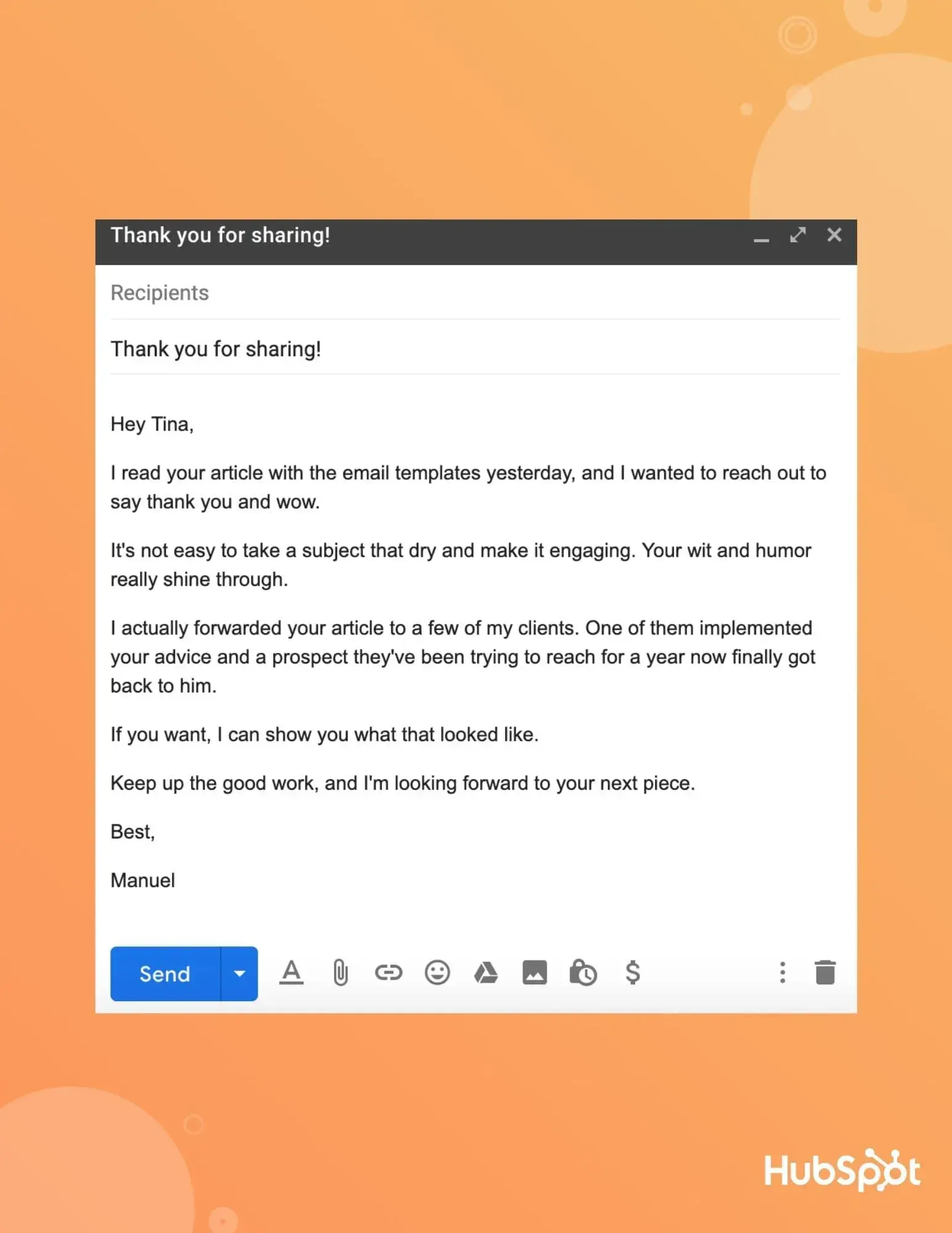
Why this email works: These templates offer kind words and helpful tips. People like to hear nice things about themselves, and receiving a specific solution to a problem along with flattering statements is a recipe for a response.
6. Build rapport using common interests.
Warning: Don’t be creepy. Salespeople of yesteryear could get away with walking into a buyer’s office, noticing the photo of the prospect’s grandchildren, and remarking, “You have a beautiful family.” Today, framed pictures of decades past have become digital photos on Facebook.
Salespeople should certainly incorporate Facebook into their research. But that doesn’t mean you should open with, “How was your grandkids’ soccer practice on Sunday?”
That’ll compel a prospect to issue a restraining order, not email you back. Instead, start with safe topics like common personal interests.
Hey [Prospect],
I was browsing through LinkedIn. Looks like you and I are both in [industry], and we’re both snowboarding fans. Have you ever dreamed of having an industry conference at a ski resort? I have.
Have you gotten out this year? I got out to Loon last month. The powder was amazing.
Regards,
[Your name]

Why this email works: You’re making a sincere connection with the prospect using information that’s typically fair game to mention — LinkedIn posts. The prospect will respect your research skills and appreciate that you were tactful in your approach.
Opening with a mutual non-work-related interest is smart for another reason: You’re giving them a break from the day-to-day and reminding them of something they love to do outside of work.
7. Congratulate the new hire.
New hires are on top of their emails more than senior employees, so you’ll have a chance at getting your email opened and read with this group. Congratulate them on joining the company, and let them know they made a great decision.
[Prospect],
Congrats on your new role with XYC Recruiting. I’ve heard amazing things about the company and trust you’ll enjoy working there.
I work with [Your company name], helping teams like yours increase employee retention by up to 35%. I’d love to talk with you about how your company could achieve the same results — and help you make a splash in your first few months.
Here’s a link to my calendar if you’d like to book some time: [Calendar link]
Regards,
[Your name]

Why this email works: It’s natural to respond to well wishes with a simple “thank you,” but by adding more information to your email about what you do and why you’re sending them a message, they may be inclined to take you up on your offer to meet.
8. Offer motivation.
No matter what industry your prospect works in, they’re probably going through their own trials and tribulations.
A word of encouragement might be just what they need to make it through the day. Send a thoughtful message like this one to perk them up.
[Prospect],
Today might be a day when you’re wondering how you’re going to get through it all. I’m here to tell you that you’re more than capable of doing anything you put your mind to.
The rest of the day is in your control. Make the most of it.
When you need a word of encouragement, you’ve got my email.
You’ve got this,
[Your name]

Why this email works: They’ll remember how you made them feel and appreciate the sincerity you displayed. Instead of taking the opportunity to ask for a connection, a call, or a few minutes of their time, you offered them a moment to reflect on their day and make the most of it.
9. Send them a gift.
When was the last time you received a gift card to your favorite coffee shop or had lunch covered by a friend? It’s not a common occurrence, and that makes it all the more meaningful when it does happen.
Do some research to see if you can find the prospect’s favorite restaurant and purchase an e-gift card.
Depending on your sales team’s budget, this might be out of reach for every prospect, but for the ones you feel are a great fit for your product or service or someone you’ve received an introduction to, try this email template.
Remember to use an eye-catching subject line so they don’t miss the free gift inside.
Subject: Lunch is on [company name]. Here’s a $10 gift card.
Hey [Prospect],
Remember to break for lunch today. [link team and company name here] is providing you with today’s meal.
[insert e-gift card link]
Enjoy!
[Your name]

Why this email works: The tried and true reciprocity principle never steers us wrong. A good deed begets a good deed. Your prospect will want to thank you for the gift and probably commend you on the unique approach.
Referral and Networking Templates
Referral and networking templates are for reaching out through mutual connections, whether it’s a shared colleague, vendor, or fellow industry professional. Use these when you want to open a conversation with social proof and built-in trust.
The goal is to leverage existing relationships to start a conversation. This isn’t about pitching.
It’s about asking for an introduction, offering value, or exploring mutual opportunities.
Warm intros convert better than cold outreach because trust is already established. I’ve found people are more likely to reply when you come recommended by someone they know.
10. Seek referrals.
Everyone with a quota should be part of a networking group. If you sell to bigger companies, join a group (or start one) of professionals who sell to your target market. Try reaching out to other sales professionals like this.
[Referral partner],
It looks like we both sell to CIOs in the Boston area. I meet with a handful of successful salespeople every week to talk about accounts, and we help each other with introductions to prospects. During some months, my networking group books me more meetings than my SDR.
Would you be interested in meeting for coffee to talk about how we might be able to help each other?
[Your name]

Why this email works: You’ll want to diversify your sales prospecting approach. Cold calling, emailing, social media, and talking to strangers will get you far, but adding other salespeople to your network is a way to work smarter.
I think this email template is the perfect example of the benefits of expanding your sales network.
11. Talk to your prospect’s vendors.
Vendors are another resource for learning about a company. Trusted service providers are in a great position to refer you. Not only do they know how your prospect makes purchasing decisions — they can make introductions.
Hey [Prospect],
Your commercial real estate broker, [name], suggested I reach out to you. Someone in your organization told them that booking conference rooms is a real challenge. Everything is always booked — even when people aren’t in the room.
This is an easy fix if you’re interested in solving this problem once and for all. Interested?
Best,
[Your name]

Make sure you get permission to use names when referencing vendors. The last thing you want to do is get your referral partner fired.
Ask, “Would you mind if I email [Prospect] and say that you suggested we talked?” Then, you’re free to write, “[Vendor] asked me to email you to see if I could help.” Or just call and start off with “I was talking to [Vendor], and… “
Why this email works: Not only do you have a direct way to reach a prospect, you have the seal of approval from the vendor.
The prospect probably gets several sales emails per day, but you’ll stand out because of the connection you made with the vendor prior to emailing the prospect.
12. Talk to lower-level employees.
While there is a lot of information online about prospects, nothing beats intel from a trusted source. This is especially critical if you sell to finance, IT, or other back-office professionals since it’s difficult to inspect or observe how they do their jobs from an external perspective.
I find the trick to this is starting conversations with the intention of gathering intelligence.
Every company has customer-facing employees. Start with the sales team and ask them what they’re exceeding at in their roles and what they could be improving. They will probably respond in solidarity.
Then, reach out again with the results and see how your product or service can help. If there are goals the company could reach more effectively after implementing the solution you sell, the sales team might be willing to pass along your information to the right contacts.
Hey [Prospect],
Your salespeople seem to be struggling with acquiring new clients, according to an informal survey I did. Specifically, they are struggling to initiate a dialogue with prospects like they used to.
Is it a priority for you to improve their ability to put new opportunities in the funnel?
Regards,
[Your name]

Why this email works: You’ve already received valuable survey data that you can use for your own content and sales pitches, but you can also use that data to uncover needs within the companies you’re prospecting.
13. Reference a common connection.
Once you’ve developed trusting relationships with other professionals, ask them if it’s okay to drop their names when connecting with their contacts. You might even ask them for a list of people that they recommend you reach out to.
Hey [Prospect],
I was chatting with [connection’s name] the other day, and he mentioned that your team is preparing to launch a new product. Congratulations! I know how exciting that is.
When [connection’s company] launched [their new product/service] last year, we helped create blog posts, landing pages, and a white paper to promote it and saw a great ROI.
[Connection name] thought you might be interested in our services, too. Would you like to talk?
Best,
[Your name]

Why this email works: Name-dropping can be distasteful, but not when it’s done like this. A subtle nod to your mutual connection can make a prospecting email come across as more personable.
14. Talk to friends (and strangers).
While this is not always good advice (especially for children), talking to strangers at the right place and time can be a smart idea. Whether they’re friends or acquaintances, talking to people outside of your typical peer group can lead to great connections.
Hey [Prospect],
My friend, [name], told me that you’d be willing to meet up with me to discuss my business and see if we might work together.
I reviewed your website and am particularly interested in learning more about your [service].
Do you have time in the near future? Here’s a link to my calendar to make scheduling easier.
Regards,
[Your name]

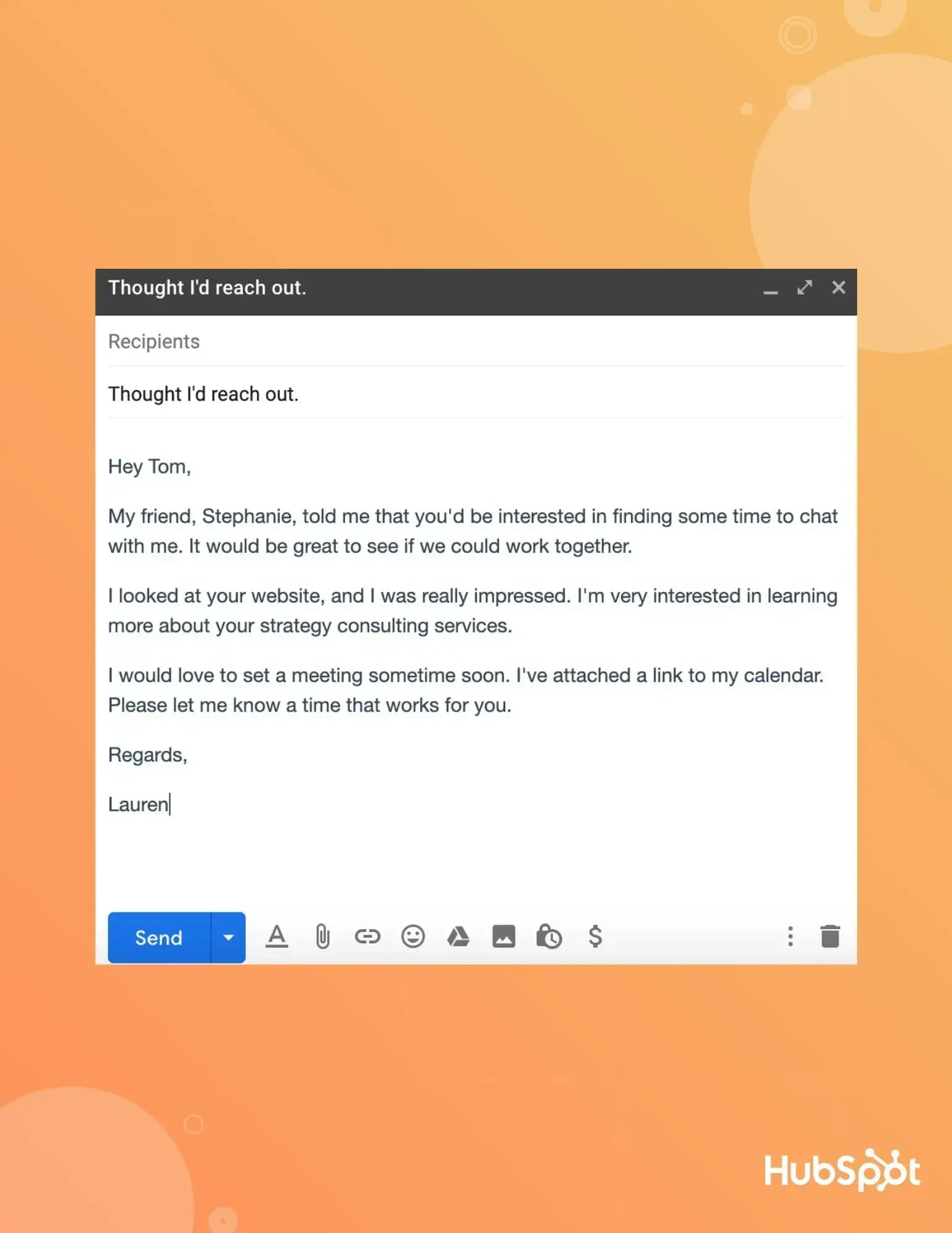
Why this email works: Similar to vendor emails, talking to strangers through a mutual friend can be more effective.
The relationship is built on a causal connection rather than a business one, so there’s no pressure to pitch right away.
Follow-up and Re-Engagement Templates
I like to use follow-up templates when a prospect has shown interest but gone quiet, whether they opened my email, clicked a link, or even replied once but then disappeared. Re-engagement templates are for reviving cold leads.
The goal is simple: Restart the conversation. You’re not pushing for a sale — you’re checking in, offering value, or giving them a reason to reply.
The fortune is in the follow-up. Most deals don’t happen on the first touch; they happen because you stay on their radar. A well-timed, value-driven follow-up can reignite interest without feeling pushy.
15. Respond to social media posts.
Social media is where your next prospect might already be raising their hand. Every time a prospect engages with a post — whether it’s yours or someone else’s — it’s an opportunity to start a conversation without the awkward cold pitch.
Think about it. They’re active, they’re engaged, and they’re showing you what they care about. So why let that moment slip away?
But here’s where most sellers blow it: They either spam the DMs with a pitch or stay invisible by lurking without engaging. The sweet spot? Join the conversation first, add value, and let the conversation naturally continue off-platform.
Here’s how to do it right:
- Comment before you DM. Show up in their comments first — acknowledge their insights, share your perspective, or drop a helpful resource. You’re building familiarity without pressure.
- Transition smoothly. If the conversation clicks, make the ask:
“Would love to keep this conversation going — mind if I shoot you a quick DM?” - DM with context. When you do reach out, reference the post:
“Loved your take on [topic] — I had a similar experience with [insight]. Curious, how do you approach [related challenge]?”
[Prospect],
I’ve really enjoyed our exchange on [topic]. I learned a lot from your insights.
The other day, I came across this study that confirms your intuitions, so I just wanted to pass it along: [link to study]. I’d love to hear any other thoughts you have.
Warmly,
[Your name]

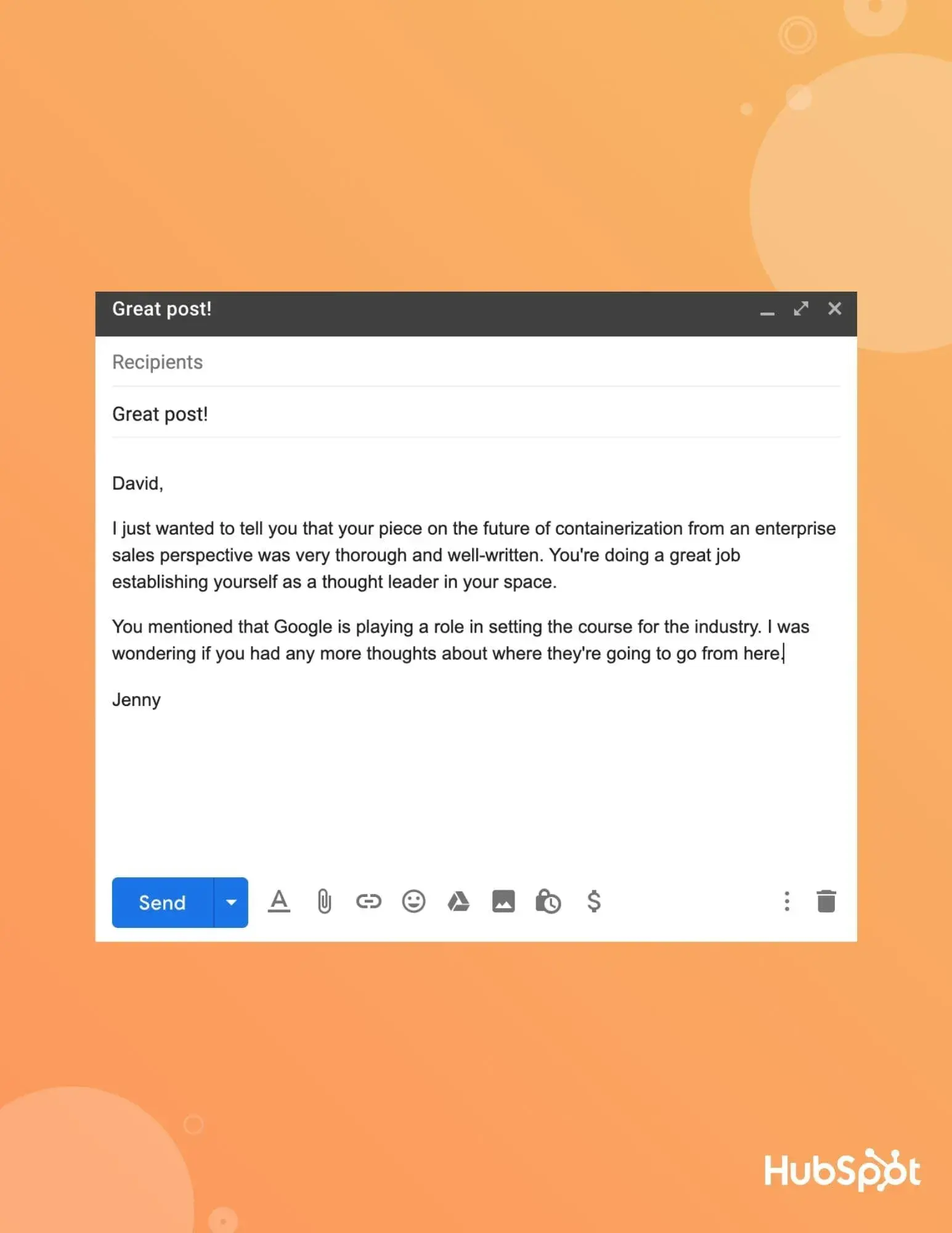
Why this email works: You’re continuing the conversation from an interesting post.
This could lead to new ideas, solutions, and even a discovery call about a need the prospect has that your products and services could solve.
16. Respond to content your prospects publish.
Pay attention to what your prospects are publishing online. They are sharing massive clues about their current initiatives that provide great openings for dialogue.
Here’s an email I wrote up for an SDR from RingCentral who asked for some advice:
Hey Jeetandra,
Your CEO posted an article about expanding globally, which speaks highly of the work you’re doing. Judging from a quick LinkedIn search, I can see you’re the guy who is probably making that happen. Congrats on the success. I know it’s hard to duplicate the success of the home office.
Usually, managing directors are involved with setting budgets and are under pressure from CFOs to minimize startup cost. I’m an expert at helping companies minimize these types of expenses.
I talk to people like you all day. Would you be interested in a checklist of ways to reduce expenses?
Regards,
[Your name]

Why this email works: Reading an unsolicited sales email or a piece of unsolicited advice isn’t at the top of anyone’s priority list. This approach keeps your email relevant and useful to the prospect.
17. Send your company’s content.
For every title or persona that can influence your sale, have content on hand that addresses their specific challenges.
Hey [Prospect],
Your blog article about [topic] was excellent. Your ebook on the topic was even better. The part about [section] was amazing because [reason].
But, I had to click around your website quite a bit to find the ebook. Have you ever thought about putting a call-to-action on the blog post that encourages visitors to download your whitepaper on the same subject?
Here’s an article on how and why to do this: [link]
Let me know what you think,
[Your name]

Why this email works: You’re working smart, not hard. Rather than creating an entirely new piece of sales material to send to this prospect, you can pass along marketing material that has already been made and is relevant to the needs of the prospect.
Take this tactic a step further and add a tracking parameter on the blog link. Even if they don’t respond to your email, you can follow up on the backend to see if they’ve clicked the link to read the article.
I think this type of email works great as an end-of-the-month sales email, which can be sent to prospects and current customers as a way to engage, re-engage, and upsell.
18. Send other people’s content.
Don’t only send your content. Prospects will be less suspicious of your intentions if you send other people’s or other companies’ content that could be helpful for their situation.
Hey [Prospect],
Congrats on closing your seed funding. That means you’re probably starting to think about how you’ll raise your A round.
Other founders report that it’s 100x easier to raise money if they’ve already figured out how to profitably acquire customers.
I’ve found that David Skok’s articles on unit economics are an amazing resource to help with that.
Here’s one: http://www.forentrepreneurs.com/saas-metrics-2/
Have you read them?
Regards,
[Your name]

Why this email works: The point is to show them that you care about their success and you want to help them reach it no matter what. And yes, that includes sharing other people’s content if you have to.
19. Publish original content.
For the last few years, I’ve regularly asked my young son, “How do you get better at things?” Without hesitation, he now says, “Practice.” Not every salesperson is a natural writer, but I’d highly recommend they all start practicing.
Why should salespeople write? Prospects willingly talk to critical-thinking, problem-solving, and effective salespeople if they have experience relevant to the prospect’s world.
So, write about your daily experiences helping prospects. Share your wisdom.
While publishing content to your company website is the best way to go, it’s only good for you if you’re able to track which of your prospects reads your posts.
If you don’t have marketing automation software in place that tells you when your prospects are visiting your website, publish to LinkedIn instead. As long as your 1st- and 2nd-degree network consists of prospects, there is a chance they’ll read what you post.
When they like, comment on, or share something you wrote, start a dialogue by using a variation on the template below:
[Prospect],
Yesterday, you liked my article on LinkedIn. What did you like about it?
[Your name]

Why this email works: The really great thing about content is that it keeps on talking with prospects even when you’re sleeping, exercising, or eating.
It works around the clock for you. Every other prospecting method is ephemeral (especially email). Imagine what salespeople could do if we combined the staying power of relationships with the lasting power of content.
20. Monitor who views your LinkedIn profile.
LinkedIn is an invaluable networking site. It’s where you share about who you are and what you do, so you want to keep an eye on who’s viewing your profile. If they’re looking at your profile, chances are they’re interested in what you have to offer. It’s a sort of soft inbound strategy.
Don’t miss the opportunity to connect with them and start a conversation.
Hey [Prospect],
I saw your recent LinkedIn post expressing your [pain point]. I just wrote a short piece on [topic of expertise] and thought you might enjoy reading it. It offers insights on [pain point] and a few strategies I’ve found helpful in addressing it.
[link to article]
I regularly post on [topic] and related topics, so feel free to give me a follow on LinkedIn if you’d like to discover more insights.
Best,
[Your name]

Why this email works: It’s short and to the point, giving the prospect a reason why they might want to accept your connection and visit your profile again in the future.
21. Put their name in lights.
If you are publishing content, ask for feedback on your drafts. You can also ask prospects for quotes to add to your article.
[Prospect],
Thanks for connecting with me on LinkedIn. From looking at your impressive career advancement from salesperson to sales director in just five years, I’m guessing you have some really valuable advice.
I read a few of your testimonials and I noticed that many of them said you put people first. Many of them said that you always drop what you’re doing to listen to the concerns and ideas of your front line salespeople.
Would you be willing to contribute to an article I’m writing on that subject?
Regards,
[Your name]

Why this email works: People like being asked for help or being asked for their opinion on a topic. This might not seem like the perfect introduction to your next big sale, but it’s a smart way to get a response.
22. Ask for advice.
Most people like to give advice. Asking for advice appeals to their ego. (See the “esteem stage” of Maslow’s hierarchy of needs. In the age of social media, many of us get stuck at the esteem stage on our path toward “self-actualization.”)
Psychology 101 aside, asking for advice is a hard request for most of us to resist.
[Prospect],
From your LinkedIn profile, it looks like you’ve been working in aerospace for 20 years. I’m guessing you’ve been involved in many engineering advancements in that timeframe.
I’m only two years into the aerospace industry, so I lack some of the historical context I imagine you have.
I’m working on a new product right now. If I shared some of my findings, would you be willing to give me feedback?
Regards,
[Your name]

Why this email works: It shows humility and respect for the prospect and their contributions to the industry in which you work.
23. Ask for a recommendation.
Similar to the above, asking for a recommendation shows humility and deference to someone with more expertise than you. It’s also a great way to start a conversation with a simple request that won’t take too much time for your prospect to respond to.
[Prospect],
A colleague of mine is investigating solutions for predictive lead scoring. I’ve been following you online for a bit.
As an expert at sales, I’m wondering if you have any experience with these platforms or know anyone who does.
[Your name]

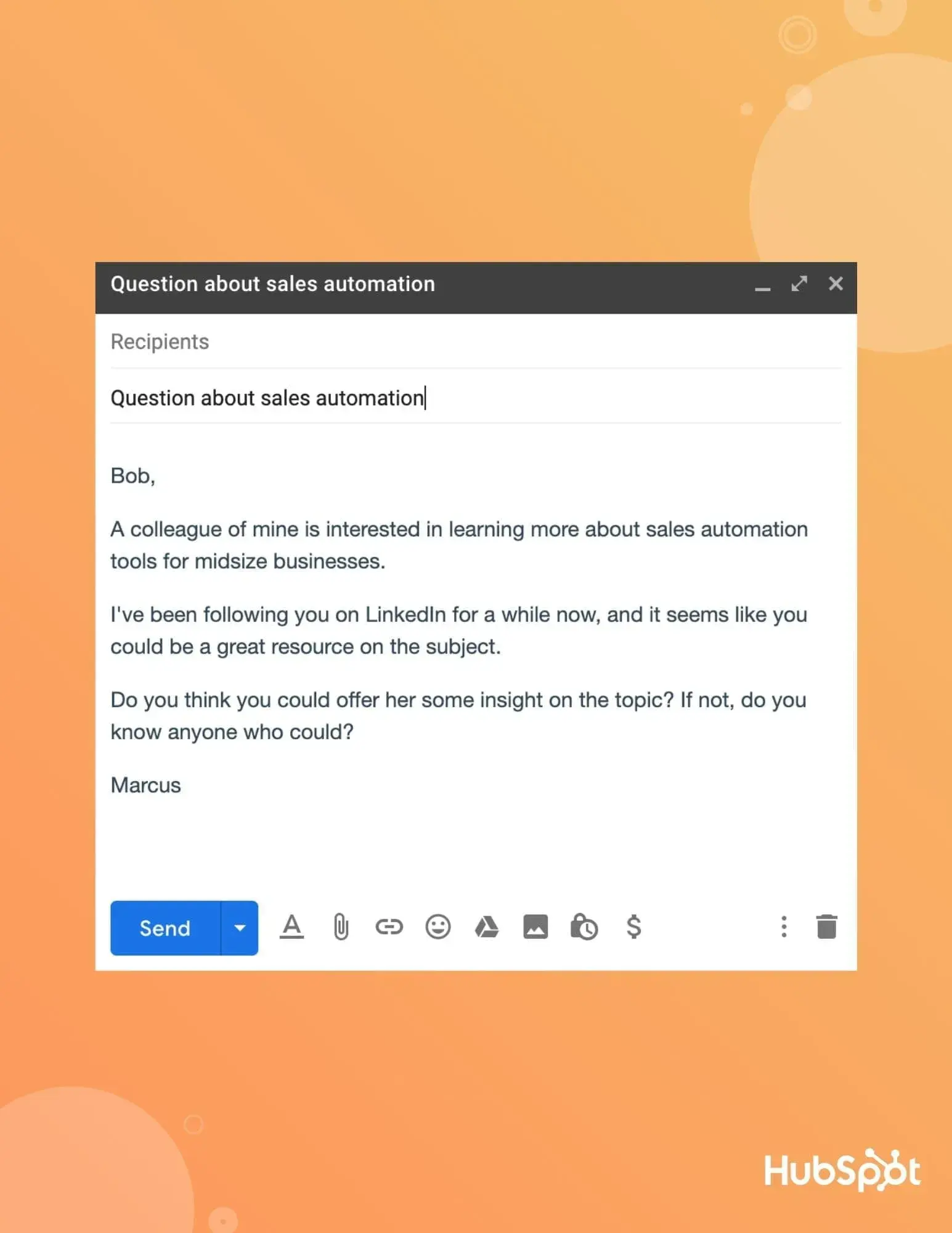
Why this email works: The requests in these examples are sincere and easy to oblige. You’ll find that people are more than happy to help.
Market Research and Opinion-Seeking Templates
Use these templates when you want to engage prospects by seeking their expertise or insights. These are perfect for:
- Gathering opinions for a survey, blog post, or industry report.
- Validating market trends.
- Asking for advice or recommendations.
The goal is to start a relationship by making the prospect feel valued as an expert. Instead of pitching, you’re collaborating — which often leads to future conversations.
People love sharing their opinions — especially when they feel their expertise is recognized. Plus, asking for insights opens the door to follow-up with results or opportunities based on their feedback.
24. Talk to your prospect’s customers.
Your prospect’s customers and partners are also great sources of insights. If your prospect has a case study page, look at it, or check out reviews about it online.
Hi [Customer of prospect],
My name is [name] and I work with [company] to help clients [achieve goal].
I saw that you are working with [prospect’s company] to achieve [goal]. I’m doing some industry research on companies like [prospect’s company]. Would you be willing to contribute?
If so, I’d love to hear about your experience with [prospect’s company]. You can respond via email, or we can set up a quick phone call: [link to your calendar].
I look forward to hearing back from you!
Regards,
[Your name]

Why this email works: More often than not, you’ll find positive information that will get the prospect talking.
But, if you hear from a disgruntled or unsuccessful customer, use that information too. You could motivate the prospect to turn those negative reviews into positive ones — hopefully using your company’s products to do it.
25. Offer an introduction.
Offering your network as a resource to others is a great way to help them out and build rapport. By serving as an introduction, you make yourself an invaluable connection.
[Prospect],
On LinkedIn, you posted a request for introductions to salespeople who successfully practice social selling.
I have a few that I could recommend. Would you like an introduction over email?
[Your name]

Why this email works: You’ll have more opportunities to get in front of the prospect with each introduction you make. And when those sales reps have calls with the prospect, they’ll mention that they both know you and sing your praises.
The prospect will become fond of you, and when you reach out again, you’ll be met with excitement rather than skepticism.
26. Run a custom analysis.
Depending on what you sell, it might be difficult for you to evaluate your prospect’s situation. But, if you can evaluate it, do so. Then, send them the results.
[Prospect],
I used some software to evaluate the search rankings of the top 50 B2B accounting firms in the Boston area. Although your firm ranks in the top 25 according to the Business Journal, your search rankings are worse than the top 40.
Would you like to view the report?
[Your name]

Why this email works: Chances are you don’t sell marketing services, but if you do, use this approach. If you don’t, try to find something you can analyze that your ideal buyer will care about.
27. Provide insights.
According to Mike Schultz, author of Insight Selling, “Educating buyers not only shares the seller’s expertise, but it also demonstrates the seller’s willingness to collaborate with the buyer.” I’ve found this is another invaluable source of rapport-building.
[Prospect],
Looks like you started a blog, but have stopped publishing. Oftentimes, companies stop prioritizing blogging when results don’t come immediately.
But did you know that companies that blog regularly generate 67% more leads than those that don’t?
[Your name]

Why this email works: It provides useful information that is highly relevant to the prospect. Tailor this approach to any new venture or project your prospect has taken on. This could be the data they need to validate the effort they’re putting into it.
28. Ask them what they want to learn from peers.
Marketers use surveys to gather proprietary data. Salespeople should borrow this playbook.
Engaging prospects in the design of the survey will ensure the results are interesting for the ideal buyer profile. This is also a suitable reason to reach out, which can initiate a dialogue.
[Prospect],
You look like you have an impressive amount of experience doing [X]. I’m designing a survey and will be asking 100 people with similar experiences in [role] and [industry] about their thoughts on [topic].
If you had the opportunity to ask any question of 100 peers, what would you ask?
[Your name]

Why this email works: You’re building a relationship with the prospect while generating interest in the results of the survey.
When you release it, you’ve already established a reason to reach out to them again with a stronger pitch based on the data in your report.
29. Invite them to participate in market research.
Taking the email template above a step further, you can reach out to the prospect again once you and your team create the survey. Now, you can ask the prospect and their team to take the survey.
[Prospect],
Thank you for your assistance in designing this survey. Will you take the survey now that it’s ready? It’s five questions long and should take you five minutes.
As soon as we have 100 respondents, I’ll send you the preliminary results.
[Your name]

Why this email works: The great part about surveys is that you can ask tough questions about challenges and goals. It’s hard to do that on a phone call right away.
Don’t forget to sync your survey software with your CRM and marketing automation software so you can see the responses and use them to customize your future sales and marketing touches to each contact’s context.
30. Get their opinion.
Ask your prospects about what they think about something. Just be sure you actually plan to use their opinion in some way — don’t ask an empty question.
You can let them know their response might be featured in some content that your company will publish in the future. Or you may be using their qualitative data to validate some quantitative data from a survey you did.
[Prospect],
Looks like your marketing efforts support a pretty big sales team.
At HubSpot, we recently completed a survey of B2B buyers. We asked them to give one word that best describes salespeople. The most popular answer by far was “pushy.”
Do you agree or disagree with this? Do you think your buyers think your salespeople are too pushy? Do you think this reduces the effectiveness of your marketing?
Regards,
[Your name]

Why this email works: You’re actually challenging the salesperson stereotype by acknowledging that people often find sales reps pushy.
As a salesperson, you’re actively negating that characteristic by taking a collaborative and curious approach to the prospect.
31. Ask them if they want access to market research.
Offering access to market research is giving your prospect value without asking for anything in return. It’s a great soft opener to a conversation about how their business is performing and any pain points your product or service may be able to address.
[Prospect],
Your quarterly report shows an impressive growth rate, especially at your scale.
Fast growth companies like yours usually dedicate significant resources towards recruiting. We have some market research that shows how companies allocate resources to different parts of the recruiting process.
Would you be interested in seeing the report so you can benchmark yourself?
Regards,
[Your name]

Why this email works: If you used this company in your market research, you’re showing them the final project where their responses were featured. Moreover, you’re sharing some valuable industry insights that the prospect will likely find useful.
32. Ask if you’ve got the right person.
People have a natural tendency to want to help others. Make the most of that and send an outreach email that asks, “Could you help me get in touch with the right person?”
[Prospect],
I’m trying to reach the person who’s in charge of implementing marketing software at your company.
I’ve helped businesses like yours increase marketing-qualified leads by as much as 25%.
Could you help me get in touch with the right person?
Thanks for your time,
[Your name]

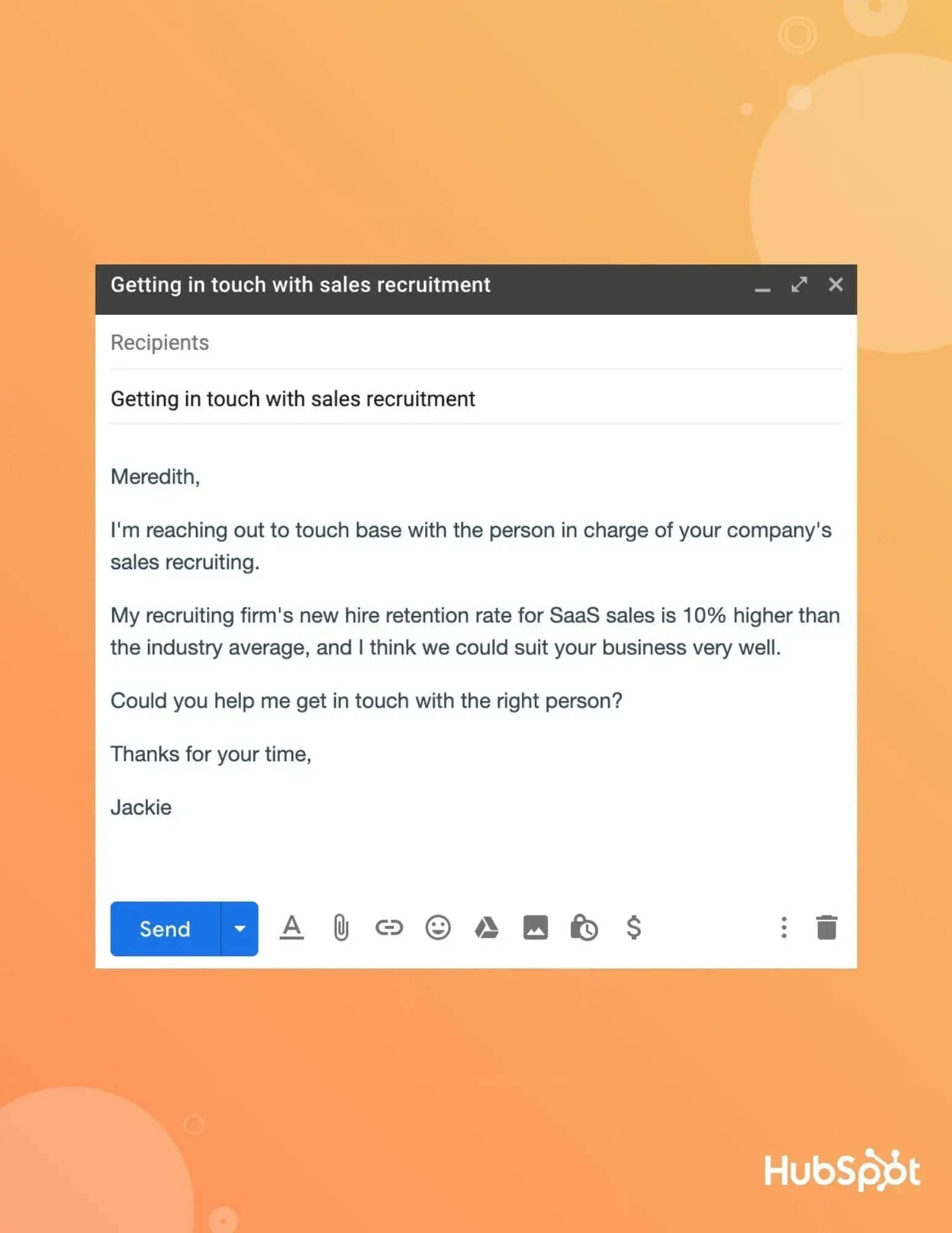
Why this email works: You’re letting the person you emailed off the hook. Because they know you’re looking to talk to someone else and just need their help to do it, they’ll be happy to send you to the right person.
How to Write a Sales Prospecting Email That Gets a Response
These templates use a relatively simple set of guidelines. As you implement the approaches shared above, I recommend using these guidelines to customize your templates. I break down my writing process into phases: pre-writing, writing, and reviewing. Each consists of multiple steps, which I have laid out below.
Pre-Writing Phase
The pre-writing phase consists of researching your prospect thoroughly. You need to know who you’re writing to before you can craft an email that will land.
In my research, I always:
- Study my prospect’s business, industry, and potential pain points.
- Identify specific ways my solution can help them.
- Find points of connection or relevant recent company news.
Writing Phase
A strong prospecting email needs to include the following components. When writing, I follow these steps.
- Craft an attention-grabbing subject line.
- Make it relevant to their business interests.
- Keep it concise and compelling.
- Avoid spam triggers and excessive punctuation.
- Write a personalized opening.
- Begin with something specific about the prospect or their company.
- Show you’ve done your homework.
- Make it clear this isn’t a mass email.
- Compose the body (3-7 sentences total).
- Focus on “you” language instead of “I” or “we.”
- Only introduce your value proposition when it naturally aligns with their needs.
- Keep the message focused and concise.
- Use an open-ended approach that invites dialogue.
- Create a simple call-to-action.
- Avoid pushing for a phone call in the initial email.
- Make the request easy to fulfill.
- Ensure it appeals to the prospect’s self-interest.
- Consider ending with a relevant question that encourages a response.
Review Phase
Finally, it’s time to polish and refine your email. First impressions count, and the prospect will judge you and decide whether to respond based on how your email reads.
I always:
- Review for grammar and spelling errors.
- Ensure the total length stays within 3-7 sentences.
- Check that the focus remains on the prospect throughout.
- Verify all personalization elements are accurate.
Remember: The goal of your first email is to start a conversation, not close a deal. Focus on making a genuine connection and showing you understand their business.
Make Your Outreach More Effective
Breaking through inbox noise isn’t just challenging — it’s getting harder every day. Most cold emails get ignored, and generic follow-ups fall flat. But there's good news: While others spam inboxes with copy-paste pitches, you can stand out by building genuine connections.
The templates in this article are designed to help you start conversations that prospects actually want to continue, position yourself as a trusted advisor, not just another seller, fill your pipeline with qualified leads who see your value, and build a foundation for long-term business relationships.
Remember: These aren’t just templates — they’re conversation starters. Your goal isn’t just to get replies; it’s to begin meaningful dialogues that lead to lasting partnerships.
Editor's note: This post was originally published in July 2020 and has been updated for comprehensiveness.


